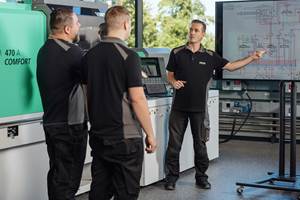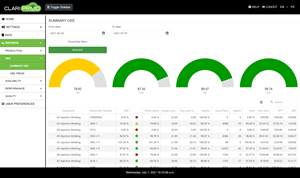Smarter & More Collaborative: Yushin Taps into Two Major Robot Trends
New Yushin robots have Industry 4.0 features and collaborative capability.
How smart can a robot be? Several answers to that question are apparent at Booth W2173, where Yushin America is putting several linear robots—and some special non-linear ones—through their paces in automated cells. Chris Parrillo, national sales manager, sees robots as part of the Industry 4.0 trend to connectivity and self-regulation. For example, Yushin’s newest and most sophisticated servo robots, the FRA series, has a new E-touch V controller that permits remote troubleshooting and predictive maintenance.
Also new is the Intu Line, a cloud-based service for reporting production statistics for the molding cell via the robot control. Such data include production counts, uptime ratio, cycle times, error counts, stoppage logs, and live images of the process taken every cycle by a camera built into the kick beam. Several FRA robots in various booths at NPE communicate their data to the cloud, where it will be displayed in the Yushin booth on smartphones and tablets. This data can also be shared with Yushin’s service personnel to quickly diagnose problems and get production back on line.
Parrillo points out that FRA robots also come with Active Vibration Control to minimize “shake” and allow faster takeout by sensing its own vibrations and counteracting them instantaneously; Arc Motion Control, which blends linear movements on multiple axes simultaneously into a smooth curve that shortens the overall path. “At the booth, we are showing how it can shave 9% to 35% off the overall cycle time,” Parrillo states.
A third “smart” function is Adaptive Motion Control, which optimizes acceleration and deceleration to minimize vibration. As Parrillo explains it, the robot automatically adjusts speeds to move faster when its axes are tucked in close to the robot body and adjusts servo speeds when the robot is working at the extremities of their axes during portions of the cycle such as part removal, insert placement, degating, or part placement.
While a number of exhibitors at NPE will show robots being controlled from the injection machine, Yushin is showing the capability of its robots to not only communicate with the press, but to act as cell managers for all post-mold activities beside the machine. Explains Parrillo, “FRA robots are equipped with protocols such as DeviceNet, EtherCAT, and EtherNet/IP, allowing simple integration with downstream equipment for conveying, assembly, decorating, visual inspection, and packaging.”
Yushin’s most elaborate cell utilizes three robots and two injection machines to mold and assemble a sports protein-drink cup and lid with in-mold labeling and post-mold pad printing. What’s more, unscrewing of both threaded parts from the mold is accomplished by the robots’ custom end-of-arm tooling with rotating servo nests—much simpler and less costly than a bulky rack-and-pinion unscrewing device on the mold.
The finished sports-drink container will be available for visitors to take home. After being assembled and decorated, the cup will be placed on a conveyor by a brand-new addition to Yushin’s robot stable—the OB-7 collaborative robot, built by Productive Robotics in California. This seven-axis device is said to operate safely around people in some applications, reducing the need for hard safety guarding. It has a mobile base so it can be moved easily between machines. And it requires no expertise for complex programming, using the simple lead-through teach method. It even has a built-in camera to read QR codes at each job station to automatically load the job recipe. A future software upgrade, says Parrillo, will enable the robot to “see” and track randomly placed parts on a conveyor.
“Collaborative robots definitely have a place,” says Parrillo. “Customers are constantly complaining that they can’t find operators to perform minor tasks, especially for short runs. These robots are perfect for basic pick-and-place jobs like case packing or tray loading.”
Related Content
Five Ways to Increase Productivity for Injection Molders
Faster setups, automation tools and proper training and support can go a long way.
Read MoreReal-Time Production Monitoring as Automation
As an injection molder, Windmill Plastics sought an economical production monitoring system that could help it keep tabs on its shop floor. It’s now selling the “very focused” digital supervisor it created, automating many formerly manual tasks.
Read MorePolyJohn Turns to Blow Molding, Doubles Its Productivity
Leading maker of portable sanitation products knew thermoforming, sheet extrusion, rotomolding and injection molding. Then it found the missing link to higher productivity and new markets: blow molding.
Read MoreScaling New Heights With Vertical Integration
Eden Manufacturing was founded on a vision of vertical integration, adding advanced injection molding capabilities to a base of precision moldmaking and more recently bringing Swiss-type machining capabilities in-house.
Read MoreRead Next
People 4.0 – How to Get Buy-In from Your Staff for Industry 4.0 Systems
Implementing a production monitoring system as the foundation of a ‘smart factory’ is about integrating people with new technology as much as it is about integrating machines and computers. Here are tips from a company that has gone through the process.
Read MoreMaking the Circular Economy a Reality
Driven by brand owner demands and new worldwide legislation, the entire supply chain is working toward the shift to circularity, with some evidence the circular economy has already begun.
Read MoreSee Recyclers Close the Loop on Trade Show Production Scrap at NPE2024
A collaboration between show organizer PLASTICS, recycler CPR and size reduction experts WEIMA and Conair recovered and recycled all production scrap at NPE2024.
Read More












